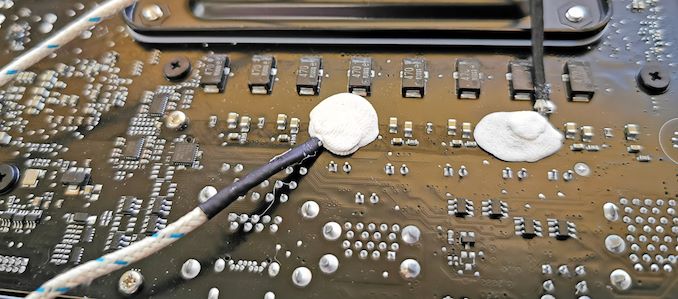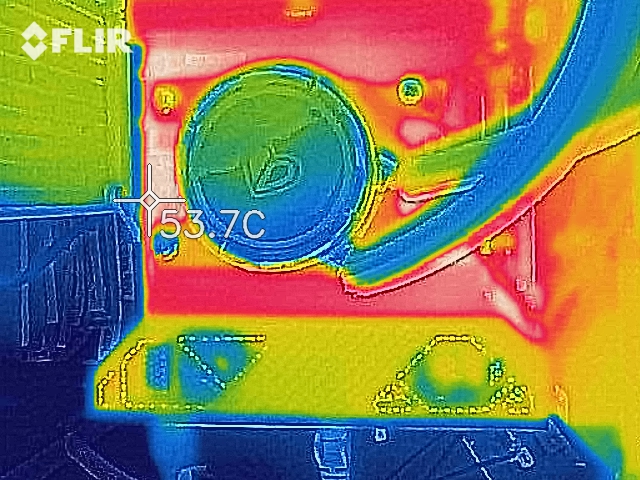The ASUS ROG Crosshair VIII Impact: A Sharp $430 Impulse on X570
by Gavin Bonshor on October 25, 2019 11:30 AM ESTPower Delivery Thermal Analysis
One of the most requested elements of our motherboard reviews revolves around the power delivery and its componentry. Aside from the quality of the components and its capability for overclocking to push out higher clock speeds which in turn improves performance, is the thermal capability of the cooling solutions implemented by manufacturers. While almost always fine for users running processors at default settings, the cooling capability of the VRMs isn't something that users should worry too much about, but for those looking to squeeze out extra performance from the CPU via overclocking, this puts extra pressure on the power delivery and in turn, generates extra heat. This is why more premium models often include heatsinks on its models with better cooling designs, heftier chunks of metal, and in some cases, even with water blocks such as the ASUS ROG Crosshair VIII Formula.

Two K-Type Thermal Probes attached to the rear of the power delivery on the ASUS ROG Crosshair VIII Impact
Testing Methodology
Out method of testing out if the power delivery and its heatsink are effective at dissipating heat, is by running an intensely heavy CPU workload for a prolonged method of time. We apply an overclock which is deemed safe and at the maximum that the silicon on our AMD Ryzen 7 3700X processor allows. We then run the Prime95 with AVX2 enabled under a torture test for an hour at the maximum stable overclock we can which puts insane pressure on the processor. We collect our data via three different methods which include the following:
- Taking a thermal image from a birds-eye view after an hour with a Flir Pro thermal imaging camera
- Securing two probes on to the rear of the PCB, right underneath CPU VCore section of the power delivery for better parity in case a probe reports a faulty reading
- Taking a reading of the VRM temperature from the sensor reading within the HWInfo monitoring application
The reason for using three different methods is that some sensors can read inaccurate temperatures, which can give very erratic results for users looking to gauge whether an overclock is too much pressure for the power delivery handle. With using a probe on the rear, it can also show the efficiency of the power stages and heatsinks as a wide margin between the probe and sensor temperature can show that the heatsink is dissipating heat and that the design is working, or that the internal sensor is massively wrong. To ensure our probe was accurate before testing, I binned 10 and selected the most accurate (within 1c of the actual temperature) for better parity in our testing.
For thermal image, we use a Flir One camera as it gives a good indication of where the heat is generated around the socket area, as some designs use different configurations and an evenly spread power delivery with good components will usually generate less heat. Manufacturers who use inefficient heatsinks and cheap out on power delivery components should run hotter than those who have invested. Of course, a $700 flagship motherboard is likely to outperform a cheaper $100 model under the same testing conditions, but it is still worth testing to see which vendors are doing things correctly.
Thermal Analysis Results

We measured 53.7°C on the hottest part of the board during our testing, the PCB around the VRMs
The ASUS ROG Crosshair VIII Impact is using a 10-phase power delivery with eight Infineon TDA21472 70 A power stages and two TDA21472 70 A power stages for the SoC which are mounted onto the rear of the PCB. The PWM controller of choice is the ASP1405I running in a 4+2 configuration but without doublers. Cooling on the power delivery is expansive with an actively cooled heatsink that has a 30 mm fan integrated into the rear panel cover, and also included a backplate on the rear which incorporates a slim heat pipe into its design. For a small form factor model, this is pretty comprehensive as both the front-mounted CPU section and rear-mounted SoC power stages all have some form of thermal reducing properties to maximise performance.
The results from our power delivery thermal testing put the ASUS ROG Crosshair VIII Impact in good stead for overclockers looking to use this board for high-performance systems. When directly compared to the other small form factor X570 model we've tested, the ASRock X570 Phantom Gaming-ITX/TB3, the Impact power delivery runs around 8°C cooler when comparing the integrated VRM temperature sensors. The performance can be attributed to the small 30 mm cooling fan over the top of the power delivery heatsink, as well as the backplate with a heat pipe integrated negating heat from the front and back. Our external probe reading does seem a little low with a reading of 49°C when compared with previous models on test, but the more heat the heatsinks can remove, the lower the probe temperature should be. The power delivery cooling solution makes the ROG Crosshair VIII Impact the most equipped small form factor board we've seen so far for overclocking Ryzen's 3000 series of processors, and with its high $430 price tag, we wouldn't expect anything less than best-in-class performance; the ASUS ROG Crosshair VIII Impact, in this instance, is certainly that.











59 Comments
View All Comments
RavenRampkin - Sunday, October 27, 2019 - link
Yup, point below me. Little correction *:DPeachNCream - Tuesday, October 29, 2019 - link
Interesting that someone feels compelled to make up rules after the fact when they find an opinion disagreeable. It points to a shortcoming in the security of your own opposing viewpoint when you lash out to say, "Oh yeah? Well you aren't allowed to wear the fire helmet when we play pretend during preschool recess because you played with the police hat last recess." Please, reflect on your thoughts before you allow yourself to lay hands on a keyboard.just4U - Sunday, October 27, 2019 - link
I can't hear the fan on my Strix x570-E at all. The fact that it's hidden from view was a bit of a selling point for me as well. Not thrilled about having chipset fans again but the fans appear to be much better quality than the ones we used to see back when they were common.AshlayW - Monday, October 28, 2019 - link
Oh, please. Have you owned X570? Have you? If not then stop complaining about things you don't know about. Your complaint is completely pointless and it just seems you've hopped on the "complain about the fan" bandwagon.Go overpay for an EOL Z390 that doesn't even have gen4, instead.
PeachNCream - Friday, October 25, 2019 - link
Typo in the Visual Inspection section, second paragraph, first line - "..SO-DIMM.2 slot abouve the main PCIe slot." - Word "above" has an extra letter in it.masteraleph - Friday, October 25, 2019 - link
While I know you haven't reviewed it, the most direct competition to this board is Asus' own X570i Strix board (ITX), which is now appearing in the wild. It also has 2x m.2 slots, one on the back and one under the chipset heatsink. The audio isn't quite as ridiculous, but the power delivery and networking stuff is mostly the same. Would love to see a comparison of the two. The ASRock board is intriguing but lacks a second m.2 slot- while Thunderbolt is great and all, 2x m.2 slots are really nice in a SFF system.mrvco - Friday, October 25, 2019 - link
I'm still unclear what you really get for an extra $140 with the Crosshair over the Strix x570-i (currently $259 on Newegg). Seems like an awful lot of money for upgraded audio with more limited SFF case options.inighthawki - Friday, October 25, 2019 - link
On "System Performance" page at the end:"and the ASUS ROG Crosshair VIII Impact did well with a latency time of 128.2 ms. "
Just FYI i think you mean to write 128.2 us (not ms) to match the table being microseconds.
a5cent - Friday, October 25, 2019 - link
I really wish Anandtech would start including the following in their motherboard reviews:- IOMMU groups
- SR-IOV support for the NIC and GPU (tested using AMD's MxGPU cards)
Dual booting every OS that needs the GPU (I have three, one for CAD, one for gaming and my main, which has Photoshop installed) is getting tiring.
I know AMD and nVidia consider SR-IOV based access to the GPU an enterprise feature, but it's about time to acknowledge that many enthusiasts could also make use of this.
Dug - Friday, October 25, 2019 - link
And performance for USB, the network, data, sound, and tb3 if it has it.It's like they want to ignore all the parts of a motherboard except some basic cpu benchmarks.